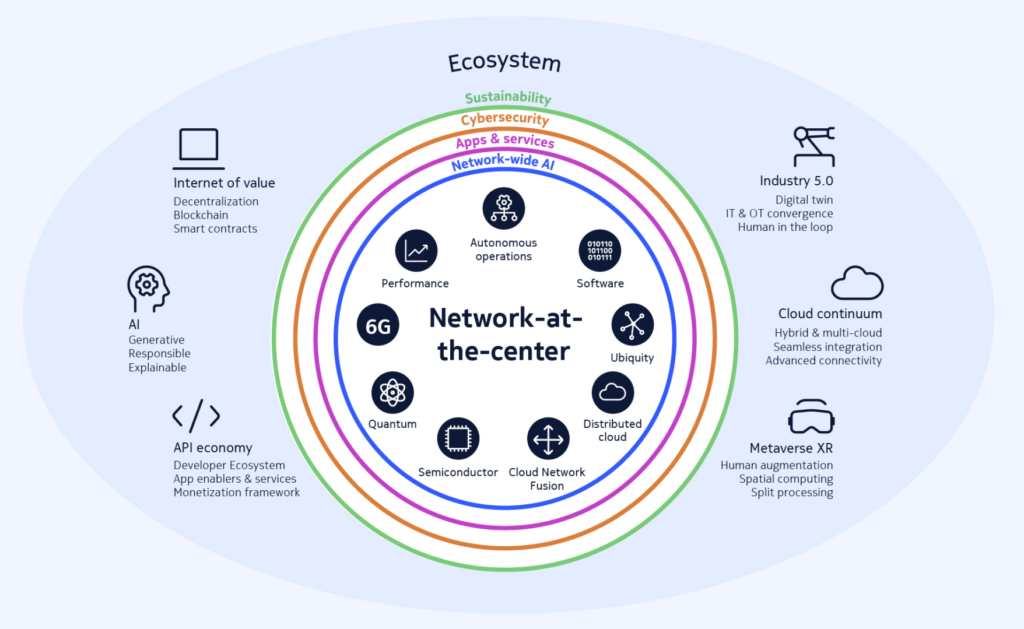-
Nokia Corporation has charted a strategic course toward harnessing the “broader potential of the metaverse,” as per their Technology Strategy 2030.
-
Nokia is working toward improving network performance to handle the demanding requirements of the metaverse and AI applications.
-
By developing network digital twin technology, Nokia envisions a network architecture that can simulate real-world objects and scenarios.
Nokia Corporation has charted a strategic course toward harnessing the “broader potential of the metaverse,” as their Technology Strategy 2030 report outlined. At the heart of this vision lies a commitment to expand its network equipment and service portfolio in anticipation of a burgeoning network demand driven by advancements in the metaverse, Web3, and artificial intelligence (AI).
From 2022 through the end of the decade, Nokia forecasts an impressive 22%–25% increase in network demand. Generative AI applications and virtual reality (VR) devices have primarily driven this surge into the mainstream. Federico Guillén, president of Nokia’s network infrastructure, relates this expected growth to the broader acceptance and integration of these innovations into the digital ecosystem.
Nokia Corporation’s Strategy for the Metaverse and Beyond
With the Internet of Value leading, Nokia designed its strategic investments to support six foundational ecosystems. This ecosystem will focus on decentralizing technology through blockchain and implementing smart contracts. Another critical area of Nokia’s metaverse strategy emphasizes human augmentation, spatial computing, and distributed processing—key elements shaping our digital interactions and enhancing our virtual experiences.
In 2022, Nokia took definitive steps by establishing two state-of-the-art labs tasked with developing and probing the metaverse and its diverse technological underpinnings. These labs have already conducted experiments in 2023 that cater to industrial needs and broader metaverse applications.
The Digital Twin: A Unique Nexus of Virtual and Real
Nokia’s pioneering work with digital twin technology forms the backbone of the proposed future network architecture. Many industries extensively use digital twins as virtual models of physical objects for testing and prototyping in fields like manufacturing and construction. One practical application of this technology has been Nokia’s collaboration in South Australia, where they used the metaverse to deliver augmented reality-based instructions for servicing Cessna aircraft—a novel approach to maintenance and support in remote locations.
Also, Read Metamask partners with Eygpt’s Vodafone Cash as plans for growth in Africa.
The innovation didn’t stop there. A pair of Finnish researchers undertook a project using digital twins, dubbed “Metahumans,” to explore how gamification could transform traditional employee management strategies. Their research delved into the visual representation of individuals within the metaverse and intricacies such as emotional and cognitive states.
These digital twins have real-world applications, including optimizing work strategies for live teams in industrial environments, establishing new safety protocols, and improving overall performance. Nokia has made significant strides in this field, paving the way for adopting these technologies in various practical settings.
Unveiling Nokia’s 2030 Technology Strategy
With its eyes firmly set on capitalizing on the expansive opportunities of the metaverse, Nokia’s Technology Strategy 2030 is laying the groundwork for a robust response to the anticipated network demand spike. This is not merely an ambition but a structured plan to equip the digital landscape with the necessary infrastructure to support an ever-evolving suite of Web3 and AI advancements.

As Nokia ventures beyond current technological thresholds, its holistic approach weaves together strategic investment and meticulous planning with an innovative perspective that promises to shape the digital economy for the next decade. This proactive stance prepares Nokia for upcoming transformations and positions the company as a leading architect of a technologically augmented future.
Nokia plans to address the expected surge in network demand fueled by the metaverse and AI advancements by strategically investing in its network equipment and services, focusing on developing future-proof network infrastructure. The company’s Technology Strategy 2030 report outlines a comprehensive approach that includes the following key elements:
Also, Read Transforming communication across Africa through decentralized internet.
It plans to significantly improve its network equipment and services portfolio to strengthen and expand its capabilities. This will enable it to manage the increased data traffic and connectivity requirements driven by the metaverse and AI technologies.
Embracing Key Ecosystems: The company focuses on six primary ecosystems, with a significant focus on the Internet of Value, which involves decentralization, blockchain technology, and smart contracts. This is crucial for supporting the transactional and data-heavy operations expected within the metaverse.
Advancing Digital Twin Technology: By developing network digital twin technology, Nokia envisions a network architecture that can simulate real-world objects and scenarios. This will be essential for testing, prototyping, and optimizing systems responding to dynamic metaverse environments.
Prioritizing Human Augmentation and Spatial Computing: Nokia intends to invest in human augmentation technologies and spatial computing, which will become instrumental in how users interact and participate within virtual spaces and metaverse applications.
Establishing Dedicated Labs: Nokia has created special facilities to further research and experiment with metaverse technologies and their implications. These labs incubate new ideas and facilitate the transition from concept to practical, scalable solutions.
Nokia has already started exploring how to use augmented reality (AR) and metaverse technologies in real-world scenarios, like providing remote technical support for maintenance. This could lead to increased operational efficiency and cost reductions.
Enhancing Network Performance and Capacity: Understanding the need for robust and capable networks to support the surge in data processing and user connectivity, Nokia is working toward improving network performance to handle the demanding requirements of the metaverse and AI applications.
Through these initiatives, Nokia aims to proactively fill the projected gap in network demand and play a key role in facilitating the growth and development of the metaverse and AI-driven services by 2030.
